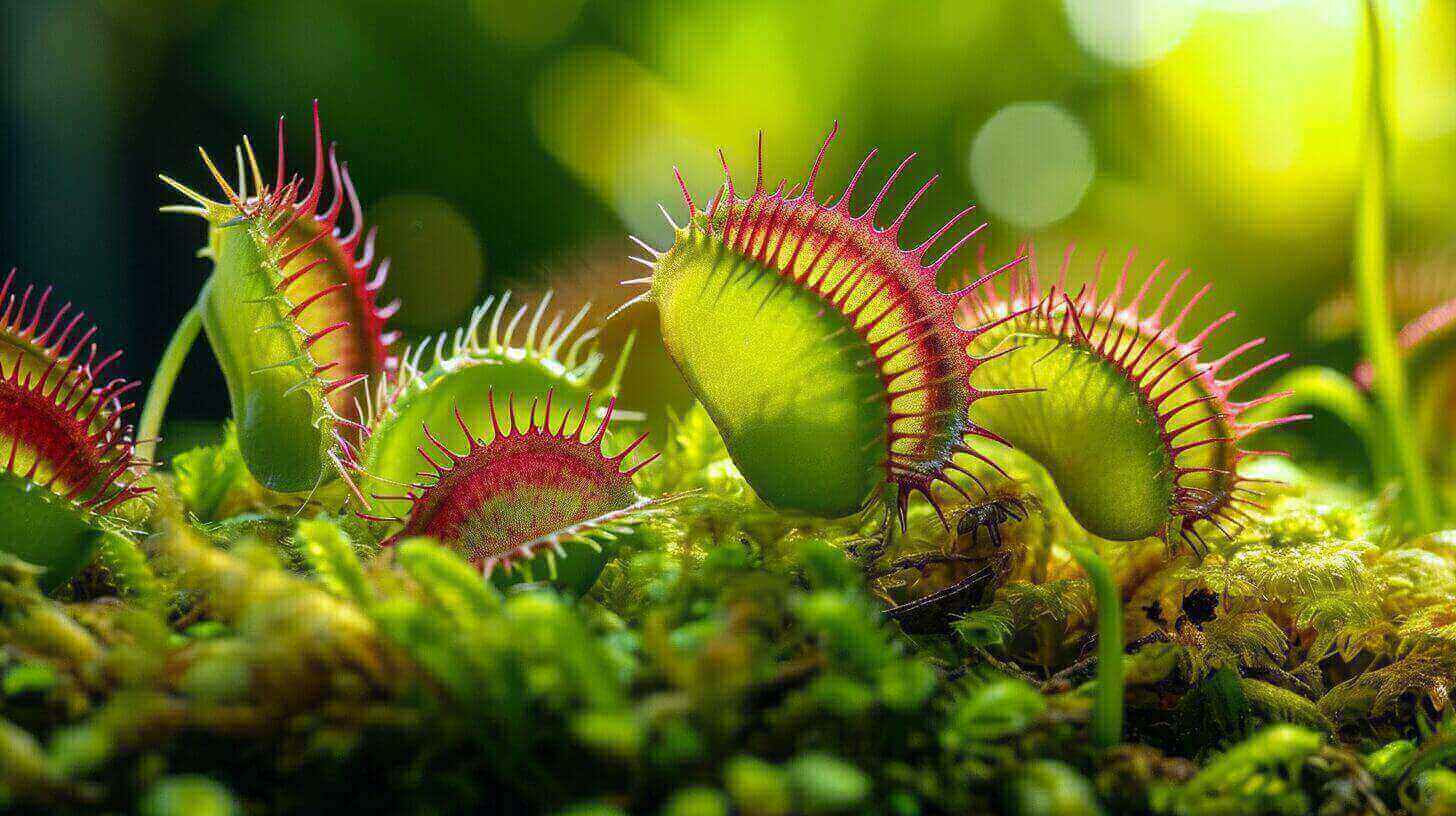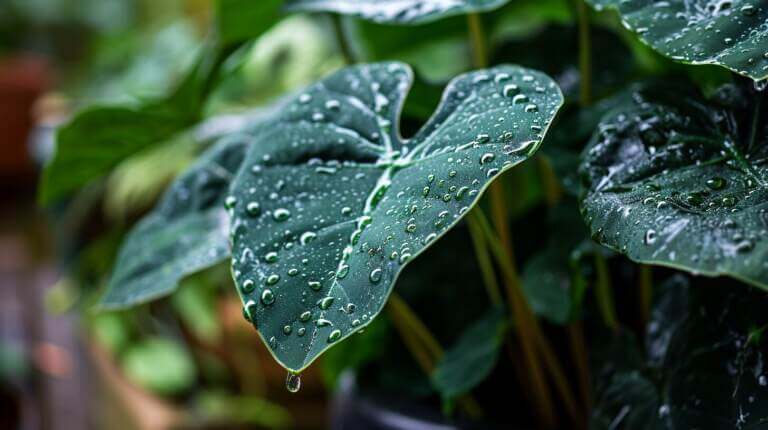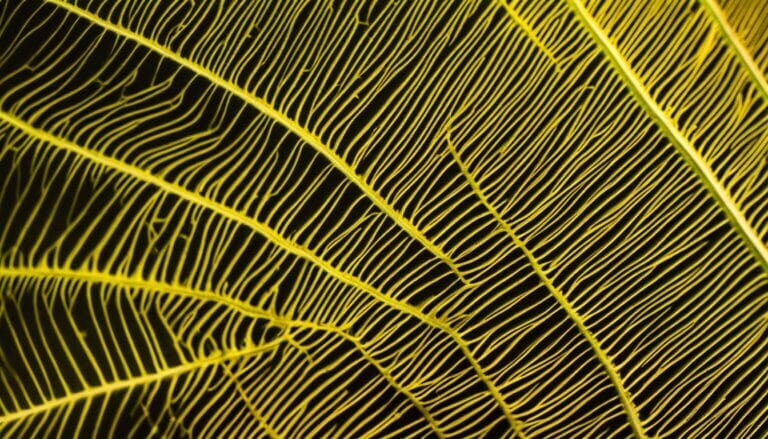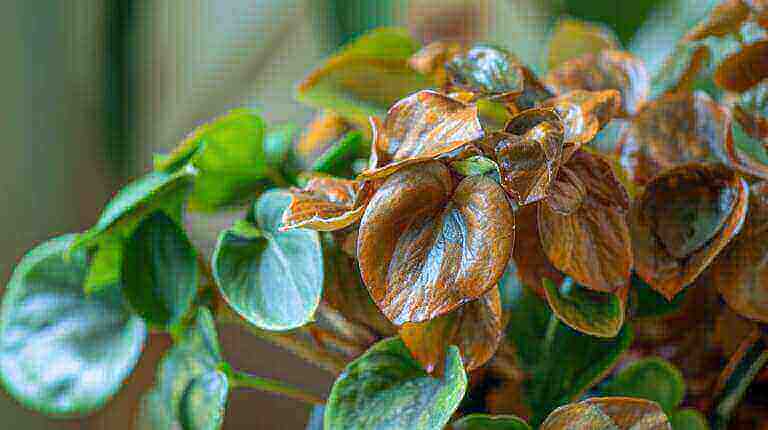Weird Facts About The Carnivorous Venus Flytrap: Venus Flytraps Behavior, Sensitive Trigger Hairs And More
The Venus flytrap(dionaea muscipula), with its unique behavior and carnivorous eating habits, continues to captivate researchers and plant enthusiasts alike. This “most wonderful” plant, as Charles Darwin called it, has some truly fascinating characteristics that set it apart from other flora. From its sensitive trigger hairs to its remarkable touch response mechanism, the Venus flytrap reveals intriguing insights into the world of plant biology.
Key Takeaways:
- The Venus flytrap’s rapid leaf closure when touched by prey provides valuable information on how plants sense their environment.
- A protein called FLYCATCHER1 plays a crucial role in the touch sensitivity of flytraps and other carnivorous plants.
- The trap closure of Venus flytraps is triggered by contact with prey through highly sensitive trigger hairs.
- The plant’s diet primarily consists of insects and arachnids, supplementing its nutrient intake from the soil.
- The Venus flytrap is listed as vulnerable due to overcollection, habitat destruction, and declining wild populations.
The Mechanism of Venus Flytrap’s Trap Closure
The Venus flytrap’s trapping mechanism is a marvel of nature. It relies on the rapid closure of its leaves, triggered by contact with prey. At the heart of this intricate process are the plant’s highly sensitive trigger hairs, which line the inside of its lobes. When these trigger hairs are brushed by prey, they generate electrical signals that spread throughout the leaf, ultimately leading to the closure of the trap.
Previous studies have suggested that calcium transport plays a significant role in the plant’s sensitivity. It was believed that two touches on the trigger hair within a short period of time were required to initiate trap closure. However, a recent study has challenged this notion. It found that even a single slow touch can lead to trap closure, suggesting that the Venus flytrap has adapted to capture a wider range of prey, including slow-moving organisms like larvae or snails.
To understand the mechanism in more detail, scientists have been studying the role of ion channels. These channels are responsible for the flow of ions, such as calcium and potassium, across cell membranes. They play a crucial role in transmitting the electrical signals generated by the trigger hairs. By investigating the specific ion channels involved and their regulation, researchers hope to gain insights into the Venus flytrap’s remarkable touch response.
| Trap Closure Mechanism | Key Components |
|---|---|
| Trigger Hairs | Highly sensitive hairs lining the inside of the lobes that generate electrical signals when touched by prey. |
| Electrical Signals | Generated by the trigger hairs and spread throughout the leaf, triggering the closure of the trap. |
| Ion Channels | Responsible for transmitting electrical signals by allowing the flow of ions across cell membranes. |
Gaining a Deeper Understanding
While significant progress has been made in unraveling the mechanism of Venus flytrap’s trap closure, there is still much to learn. Researchers are eager to identify the specific touch-sensitive proteins and ion channels involved in this process. By gaining a deeper understanding of the plant’s touch response, scientists hope to not only shed light on the Venus flytrap’s unique behavior but also uncover valuable insights into the broader field of plant biology.
The study of touch sensitivity in plants has the potential to revolutionize our understanding of how plants interact with their environment. It could provide clues about how other plants sense and respond to mechanical stimulation. Furthermore, this knowledge may have implications beyond basic biology. For example, it could inform genetic modification efforts aimed at enhancing the stress tolerance of crops or improving plant responses to environmental cues.
The Venus flytrap captivates us with its intricate trap closure mechanism and its ability to adapt to its environment. By delving deeper into the fascinating world of this carnivorous plant, we can unlock the secrets of its touch response and gain a greater appreciation for the wonders of nature.
Venus Flytrap’s Diet and Habitat
The Venus flytrap, known for its carnivorous nature, supplements its nutrient intake from the soil with a diet consisting of insects and arachnids. This remarkable plant preys on a variety of organisms, including ants, beetles, grasshoppers, flying insects, and spiders. It takes the Venus flytrap several days to digest its prey, and interestingly, it can go months between meals.
The Venus flytrap is endemic to North and South Carolina but has also been introduced to other states. In order to thrive, this unique plant requires a specific habitat. It favors moist, acidic soil and benefits from an open understory for optimal growth. Unfortunately, habitat destruction, fire suppression, and overcollection have contributed to the decline of wild populations. It is crucial to protect the Venus flytrap’s habitat to ensure the conservation of this fascinating plant.
| Venus Flytrap’s Diet | |
|---|---|
| Prey | Insects and arachnids |
| Examples | Ants, beetles, grasshoppers, flying insects, spiders |
| Digestion Time | Several days |
| Meal Frequency | Months between meals |
Understanding the diet and habitat preferences of the Venus flytrap provides valuable insights into how this captivating plant has adapted to its environment. By preserving its natural habitat and raising awareness about its conservation needs, we can contribute to the protection of the Venus flytrap and continue to marvel at its weird and wonderful behavior.
Conservation Status of Venus Flytrap Carnivorous Plant
The conservation status of the Venus Flytrap is a matter of concern, as the species is currently listed as vulnerable internationally. In the United States, there is an ongoing species status review by the U.S. Fish and Wildlife Service to determine whether the Venus Flytrap should be listed as endangered or threatened. The primary threats to this unique plant species include overcollection, habitat destruction, and fire suppression.
Overcollection is a significant problem, as the Venus Flytrap is often sought after for its intriguing carnivorous behavior. The demand for these plants in the horticultural industry, as well as illegal collection from the wild, has contributed to the decline of wild populations. Additionally, habitat destruction and fire suppression have severely impacted the natural habitat of the Venus Flytrap. These plants thrive in moist, acidic soil and require an open understory for optimal growth. However, activities such as land development, agricultural practices, and fire prevention measures have resulted in the loss of suitable habitats for this species.
To address the conservation challenges facing the Venus Flytrap, various efforts are underway. Conservation organizations and agencies are working towards preserving the plant’s natural habitats and implementing measures to reduce overcollection. These initiatives include raising public awareness about the importance of preserving this unique species and the role it plays in its ecosystem. Educational programs and outreach activities aim to foster a better understanding and appreciation for the Venus Flytrap, ultimately contributing to its long-term survival.
| Threats | Impact |
|---|---|
| Overcollection | Decline in wild populations due to demand in horticultural industry and illegal collection |
| Habitat destruction | Loss of suitable habitats, particularly moist acidic soil and open understory |
| Fire suppression | Negative impact on natural habitat required for optimal growth and survival |
“The conservation of the Venus Flytrap is crucial to maintain the balance of its ecosystem and protect this remarkable species from further decline. By preserving its habitat and raising awareness about its conservation needs, we can ensure that future generations get to marvel at the weird and fascinating behavior of this incredible plant.”
Connecting Touch Response and Plant Biology
Research on the touch response of Venus flytraps offers valuable insights into how plants sense and respond to their environment. It provides a unique opportunity to explore the fascinating intersection of touch sensitivity and plant biology. By studying the touch-sensitive proteins and ion channels in carnivorous plants like the Venus flytrap, plant scientists can gain a deeper understanding of how other plants perceive and react to mechanical stimulation.
Touch sensitivity, also known as thigmomorphogenesis, is a crucial aspect of plant biology. It allows plants to detect and respond to various stimuli, such as wind, touch, and physical support. The Venus flytrap, with its rapid trap closure when triggered by prey, exemplifies the remarkable interaction between touch sensitivity and plant behavior. Understanding the intricate mechanisms behind this response can provide valuable insights into how plants adapt and survive in their environments.
Genetic modification is a powerful tool in studying plant biology and unraveling the complexities of touch response mechanisms. However, the genetic modification of flytraps and other carnivorous plants presents unique challenges. Technical difficulties and a lack of commercial interest in breeding these plants have limited the availability and progress of genetic modification research. As a result, more research is needed to fully comprehend the role of touch sensitivity in plant biology and its evolutionary implications.
The Evolutionary Significance of Touch Sensitivity
Touch sensitivity has likely evolved in plants as an adaptive response to changing environmental conditions. By developing the ability to detect and respond to touch, plants can enhance their survival chances. For example, the Venus flytrap’s touch response allows it to capture prey efficiently, supplementing its nutrient intake in nutrient-deficient habitats. In addition, touch sensitivity may also serve as a defense mechanism, enabling plants to respond to potential threats and avoid physical damage.
| Touch Sensitivity in Carnivorous Plants | Touch Sensitivity in Non-Carnivorous Plants |
|---|---|
| Capturing prey for nutrition | Response to physical support for growth |
| Enhanced survival in nutrient-poor habitats | Ability to adapt to windy environments |
| Potential defense mechanism against threats | Response to touch during pollination |
As research on touch sensitivity in plants progresses, scientists hope to uncover more insights into the underlying genetic, molecular, and physiological mechanisms. By deepening our understanding of touch response, we can unveil the remarkable adaptations and intricate behaviors that plants have developed to thrive in their environments.
Fascinating Facts About Venus Flytrap’s Behavior
The Venus flytrap’s behavior goes beyond its carnivorous eating habits. One of the most fascinating aspects is its trap closure, which is a thigmonastic response. This means that the plant’s leaves snap shut when prey makes contact with the hair-like trigger hairs lining their inner surface. This rapid movement is a remarkable sight to behold and sets the Venus flytrap apart from other carnivorous plants in the wild.
When the trap shuts, the lobes are edged with small bristles that interlock, ensuring that the captured prey cannot escape. This motion-based prey capture mechanism is highly efficient and effective in securing its meal. The trap only closes when the trigger hairs are touched multiple times, preventing the plant from expending unnecessary energy if no prey is present.
The Venus flytrap’s behavior is a testament to its adaptability and survival strategies. By utilizing this thigmonastic response, the plant maximizes its chances of capturing prey and obtaining the nutrients it needs to thrive in its natural habitat.
| Fascinating Facts | Description |
|---|---|
| Thigmonasty | Thigmonasty is a non-directional plant response to touch, which the Venus flytrap exhibits through its trap closure. |
| Prey Capture | The Venus flytrap’s trap closure mechanism ensures that captured prey cannot escape, thanks to interlocking bristles on the lobes. |
| Movement | The rapid movement of the Venus flytrap’s leaves when triggered by prey contact is a fascinating example of plant behavior. |
These remarkable behaviors of the Venus flytrap continue to captivate scientists and nature enthusiasts alike. Exploring the plant’s unique mechanisms and responses provides valuable insights into the world of plant biology and the strategies organisms use to adapt and survive in their environments.
“The Venus flytrap’s behavior is a testament to the incredible diversity and complexity of the plant kingdom. Its ability to capture prey through rapid trap closure showcases the intricate mechanisms that have evolved over time. We continue to uncover fascinating facts about the Venus flytrap’s behavior, shedding light on the marvels of nature.” – Dr. Botanist, Plant Biologist
Conservation Efforts and Importance of Venus Flytrap
Conservation efforts are crucial to protect the Venus flytrap, a vulnerable species with declining populations in the wild. Organizations and agencies are working tirelessly to preserve the natural habitats where these fascinating plants thrive. It’s important to raise awareness about their ecological role and the significance they hold within their ecosystems.
The Venus flytrap plays a vital role in controlling insect populations, helping to maintain balance in its habitat. By preying on insects and arachnids, it helps regulate their numbers and prevents potential imbalances that could disrupt the ecosystem. Additionally, the Venus flytrap aids in nutrient cycling, contributing to the overall health of its surroundings.
Educating the public about the Venus flytrap’s unique behavior and conservation needs is paramount. By understanding the importance of these extraordinary plants, individuals can actively contribute to their long-term survival. Supporting conservation efforts, spreading awareness, and participating in responsible cultivation can all make a difference in protecting this captivating species from further decline.
FAQ
How do Venus flytraps digest their prey?
Once the Venus flytrap’s trap snaps shut, the plant begins to secrete digestive enzymes from its glands. These enzymes break down the insect prey into nutrients that the plant can absorb.
What role do digestive enzymes play in the Venus flytrap’s feeding process?
Digestive enzymes play a crucial role in the Venus flytrap’s feeding process. They help to break down the insect prey into nutrients that the plant can absorb, aiding in its survival in nutrient-poor soil.
What are ion channels in the context of Venus flytraps?
Ion channels in Venus flytraps are involved in the mechanism that causes the trap to close. When an insect touches the sensory hairs inside the trap, it triggers the opening of mechanosensitive ion channels, leading to an action potential that causes the trap to close.
How does a Venus flytrap respond to mechanical stimuli?
Venus flytraps respond to mechanical stimuli through their sensory hairs. When these hairs are touched, they trigger the opening of mechanosensitive ion channels, leading to an action potential that causes the trap to close.
What is the role of the Venus flytrap’s trigger hairs in its feeding process?
The trigger hairs inside the Venus flytrap’s trap play a crucial role in its feeding process. When these hairs are touched by an insect, they trigger the opening of mechanosensitive ion channels, leading to an action potential that causes the trap to close.
How does a Venus flytrap attract insects?
Venus flytraps attract insects using a sweet-smelling nectar. Once the insect is inside the trap and touches the sensory hairs, the trap snaps shut, trapping the insect inside.







